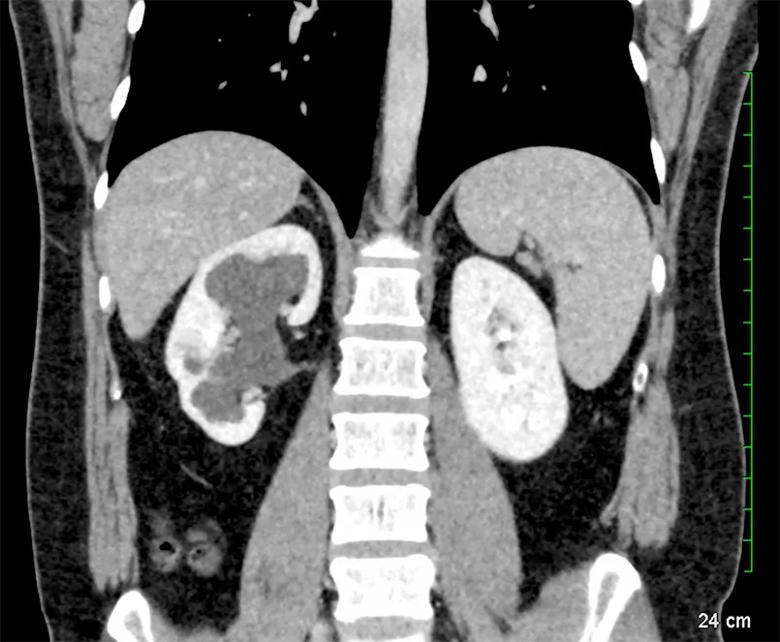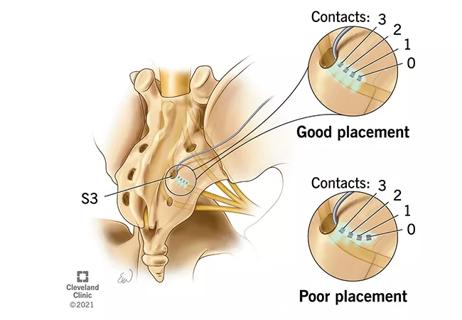Rarely used option saves patient’s renal function

Cleveland Clinic is a non-profit academic medical center. Advertising on our site helps support our mission. We do not endorse non-Cleveland Clinic products or services. Policy

Jayram Krishnan, DO, MBA
A 38-year-old male presented with intermittent right flank pain. Radiographic examination showed right-sided hydronephrosis secondary to a ureteropelvic junction obstruction (UPJO). A 2-mm stone was also noted in his right renal pelvis. A MAG-3 renal scan demonstrated a split differential of 56 percent on the left kidney and 44 percent on the right kidney. Because the patient’s pain was manageable, he opted for observation with periodic radiographic imaging.
One year later, the patient returned with a CT scan showing the stone in his right renal pelvis had enlarged to 14 mm, and his split differential function on the right kidney had dropped to 34 percent. He had worsening hydronephrosis on imaging, as well as a high-grade UPJO (Figure 1). At this point, we decided to perform surgical intervention in order to preserve his remaining kidney function.

Figure 1
We reviewed the patient’s treatment options, and he chose to undergo robotic right-sided pyeloplasty with pyelolithotomy. During surgery, we discovered his UPJO was more significant than had been indicated on preoperative imaging. Issues included a long, atretic proximal ureteral segment with intrinsic smooth muscle disease. Nevertheless, we completed the robotic pyeloplasty and left a ureteral stent in place postoperatively.
Four weeks later, cystoscopy with right retrograde pyelography demonstrated small wisps of contrast extravasing from the anastomotic repair. We decided to leave the stent in place for another month, at which time the anastomosis would be reevaluated.
Four weeks later, a CT urogram demonstrated severe persistent right-sided hydronephrosis. At this point, there were three options to preserve renal function:
Because our patient expressed a desire for definitive repair of his right kidney, we proceeded with robotic ureterocalicostomy.
Robotic ureterocalicostomy is a rarely performed treatment reserved for patients who have failed all other treatment modalities for UPJO. Although the procedure was developed in 1947 and mimics the principals of traditional open surgery, its adoption as a minimally invasive approach has been slow, largely due to technical challenges.
In ureterocalicostomy, the proximal ureter is directly connected to the lower pole of the kidney. In this patient, we performed the procedure laparoscopically with robotic assistance. First, we identified the proximal ureteral tissue and brought the ureter towards the lower pole of the kidney. The lower pole was then incised to make a calyx. A tension-free anastomosis was performed. A ureteral stent was placed and removed four weeks later in the office through cystoscopy.
One year later, our patient has no flank pain and enjoys preserved right-sided renal function.
Ureterocalicostomy should be considered in patients who have failed previous treatments for UPJO, as the procedure offers long-term benefit in the preservation of existing renal function.
Robotic ureterocalicostomy offers the same outcomes as traditional open surgery with less pain, less blood loss and a faster return to normal activities.
Dr. Krishnan is a urologist with a specialty interest in robotic surgery at Cleveland Clinic Urology, Las Vegas.

Review the advantages and disadvantages of newer interventions

Pioneering and refining the approach in pyeloplasty, nephrectomy and more

Unlike earlier pills, new drugs do not cause liver toxicity

Male factors play a role in about half of all infertility cases, yet men often are not evaluated

Hadley Wood, MD, shares her vision as the new editor-in-chief of Urology

Study leverages data from the ROSETTA trial

More on the procedure and the institutional experience

Explain some, but not all, of lower utilization